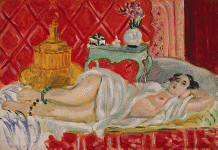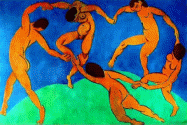Introduction
Henri Matisse (1869-1954) is the most famous name beside Pablo Picasso and Marcel Duchamp if we consider modern-day artists. The talented French artist was a printmaker, a draftsman, and a sculptor but his name goes down in history as a revolutionary artist who changed the face of post-Impressionist art, the legacy of Van Gogh, Paul Cezanne, Paul Gauguin and Georges Seurat. He trained to be an artist in Paris at the Academie Julian and learned conservative Flemish landscape art and still-life under the classic painter, William Bouguereau. However, it was Gustave Moreau, an iconoclast in the world of art, who taught him to break free from traditional methods of painting to find his own medium and style of expression. Matisse had commented on his teacher’s influence, “He did not set us on the right roads, but off the roads. He disturbed our complacency” (Stangos, 12).
Background
Matisse’s world changed when he got acquainted with the painter John Peter Russell on a vacation on an island in Brittany. Russell had been very close to Van Gogh and he showed Matisse the violent, colorful, vital Impressionist paintings of Van Gogh, Cezanne, Seurat and Gauguin which introduced Matisse to ‘color theory’ which changed his style of painting forever. He developed his own style by following the Pointillist technique of Seurat, which was the art of painting with contrasting colors in miniature dots on the canvas. He got the idea of perfect line and form by studying the sculptures of Auguste Rodin and Japanese art (Klein, 118). His love for the South of France, the vibrant colors and the love of primitive or oriental features in portraits came from Gauguin’s Tahitian portraits. Most importantly, it was Cezanne’s work, Three Bathers that influenced Matisse’s perfection of human structure and color, thus making him more famous for his portraiture. He met Pablo Picasso quite late, around 1904. Picasso was twelve years younger than him but the duo influenced each other’s painting style immensely and revolutionized the traditional, conservative form of portraiture. Matisse’s last portraits were Cubist in style, like Picasso’s whereas Picasso’s sense of clashing colors and backgrounds comes from Matisse (Osborne, 334-339).
Major influence
Matisse’s portraiture was also influenced by the artistic movement of Fauvism. Les Fauves, which meant ‘ The Wild Beasts’ was the term coined for a group of modern artists like Matisse and Andre Derain, Albert Marquet and Maurice Marinot, whose painting was characterized by what seemed like wild brushwork, bold and sometimes outrageous color schemes, and abstraction of subject matter— a simplification which was an after-math of Van Gogh’s Post-Impressionist Technique, Paul Signac’s Neo-Impressionism and Paul Gauguin’s saturated color use in his paintings of Tahiti. Thus, Matisse’s initial work was highly criticized as primitive, vulgar or wild art. During his Fauvist period (1901-1905), Matisse produced famous portraits in a Mediterranean seaport called Collioure, on vacation with Derain. His portraits were usually brilliantly colored, used a variety of brushstrokes like thick impasto, and use flat pigments which were complemented by a sinuous, arabesque line, like sculpture. His famous portraits, Woman with a Hat, his portrait of Madame Matisse called The Green Line, Marguerite Reading, The Young Sailor, Le Luxe, Blue Nude; Memory of Biskra were among his creations. They were not well received at first due to the shocking and unconventional use of color and the unrealistic kind of portrayal of the human face or the model’s figure; however, they received patrons in a short while. Matisse used vibrant and clashing colors like dark blue, green, pink, orange and yellow on a canvas, heightening the effect of the portraits and trying to catch the atmosphere of the colorful Mediterranean town (Stangos, 186).
Early Works

During the years of 1908-13, Matisse tried to go back to traditional portraits for a while, in the city of Nice, set on the French Riviera where he settled down for life from 1917. This was the period of his famous ‘Oriental Odalisque’ portraits. He wanted to paint the models in set-ups of oriental harems and like prostitutes so as to gain a character that would be balanced and serene in his portraits. He was criticized for this as art critics suggested that Matisse was painting beautiful pictures for the rich. His most famous portraits at this time include the series of nudes, in large canvases called Reclining Odalisque (Fig.1) and The Blue Nudes series.
The Reclining Odalisque, also known as Harmony in Red, is 38.4 x 55 cm Oil on canvas. It was painted in 1927 and presently located in Jacques and Natasha Gelman Collection from 1998 (Osborne, 335). In the painting Reclining Odalisque, in particular, he captures the essence of a feminine structure, the softness, and the graceful beauty of the abstract body form in these portraits. His main subject was the female figure that would be dressed exotically like an odalisque (a woman in an oriental harem). She would be painted in various forms and postures with a background of southern light, decorative patterns on a set designed inside Matisse’s house and bright colors in the background, suggesting a harem to the viewers (Osborne, 334-339).
Next followed a period of experimentation with Picasso’s Cubist techniques, which led to austere looking, geometrically structured and very abstract portraits and landscapes, the most famous portraits being The Piano Lesson, Plumed Hat, Bathers by a River. These portraits usually included a seated figure and the model’s head would be poised against a thin, neutral background, but the portraits themselves were meticulously drawn (Klein, 154).
Experiments
Matisse experimented with still-life portraits, pen and ink drawings of various models and lastly, his form of working with cut-outs of painted paper to make his famous murals. In the 1940’s, Matisse invented his famous technique of drawing sensitive and elegant, unshaded portraits of female models which were very simplified studies of line and structure, rather than color or atmosphere. After the 1940’s and primarily in the 1950’s, Matisse’s portraits become vivid and bolder as his lines are bolder, the contour line of his portraits and drawings are thicker and the forms of the figures are even more simplified and abstract. His famous drawings of acrobats were made with the innovative technique of painting with a thick brush held at the end of a long stick so that the contour lines are heavy and perfect for defining the figure. In his series of cut-out paintings like Blue Nudes, he mixes form and space by making the space complement the figure which leads to an almost sculptural accuracy of the line (Matisse, 14).
Exceptional works

The Dance was painted in 1910 and it is a 260 cm × 391 cm Oil on canvas. At present, it is located in Russia in The Hermitage of St. Petersburg (Osborne, 337). The Dance (Fig. 2) was the best work of Matisse if fluidity and grace are the markers of great portrait painting. It has been called the most convincing image of physical ecstasy in twentieth-century art. Matisse got the idea for the painting in the French suburb of Collioure in 1905 where he watched a group of fishermen and peasants doing a circular dance on the beach, called the ‘sardana’. He captures the intense form of the dance in his portrait, which shows figures in red, holding hands and whirling in a circle with complete physical abandon. It seems like a circle of twisting, maenad-like figures or they can be historically traced to the red-figure vases of ancient Mediterranean culture or to the primitive cave paintings of Egypt, capturing the ancient motions of the human body (Osborne, 338). Other famous Portraits of Matisse can be enumerated as Portrait of Madame Matisse(The Green Line), Self-Portrait in a Striped T-shirt, The Young Sailor, Blue Nude, Bathers with a Turtle, The Dance, The Conversation, Zorah on the Terrace, Woman on a High Stool, The Painter and his Model, Woman Reading and Plum Blossom. (Klein, 115)
Famous Models of Matisse
Matisse’s first wife, Amelie helped him produce the revolutionary canvases like Woman in a Hat, Portrait of Madame Matisse and the Blue Nude. The last-mentioned portrait was a violently distorted picture of Amelie who had been posing under a sunlit glade beneath palm fronds. The next model was Greta who posed for his bold portraits like The Girl with Green Eyes, The Algerian Girl, Girl with Black Cat, Girl in Green. However, she was quite offended to find that Matisse had distorted the line of her figure and her face to suggest abstraction. Lorette, an Italian model was painted in The Italian Woman, which became famous for its geometrical lines and curves which brought out the pathos of the sad and emaciated model. He then explored Lorette in different costumes, like a Spanish girl, a Turkish girl, a Parisian coquette and a waif. He is said to have painted Lorette about 50 times. When he moved to Nice, he got a 19 yr old Antoinette Arnoud to pose for him in several homely costumes like a cheap straw hat with an ostrich feather sticking out from it, a white housecoat, seated on the window wearing harem pants and loose garments or posing with a pot of coffee. She personified French chic in all his portraits. The last model and his companion in his last days, Lydia Delectorskaya was called ‘The Ice Princess’ because of her golden hair, blue eyes, white skin and perfect features. She posed as a nymph being pursued by a satyr, which was both gentle and seductive. Their collaboration was misunderstood by Matisse’s second wife who left him after 41 years of marriage and Lydia took care of Matisse till his death (Osborne, 334-339).
Conclusion
Matisse was a perfectionist about the structure and so he made his models tire out sometimes, painting them in various different poses until the perfect structure and angle appealed to him. As long as he worked, he remained high-strung and almost violent in mood which was intolerable for the models who worked with him but it was this tension that led to his creative finesse. There was always an erotic charge in his portraits and he often had love affairs with his models but the most passionate desire and lust lay in his being able to capture the form and essence of human beauty, as in Rodin’s sculptures. He seduced himself with painting at every fresh canvas and has been quoted as saying that he feared he would go blind as he is too engaged with colors that are extremely enchanted. Matisse brought out the primeval and the innocent beauty of the human form in his portraits.
Works Cited
Klein, John. Matisse portraits. NY: Yale University Press, 2001.
Matisse, Henri. Matisse portrait drawings. London: Dover Publications, 1990.
Osborne, Roy. “A Painter’s thoughts on color and form”. Color Research & Application, 12.6, (1987): 334-339.
Stangos, Nikos. Concepts of modern art. Ed. 2, London: Harper & Row, 1981.
Matisse, Henri. Reclining Odalisque (Harmony in Red). Jacques and Natasha Gelman Collection. 1927. Web.
Matisse, Henri. The Dance. The Hermitage, St. Petersburg. 1910. Mac.dom. Web.